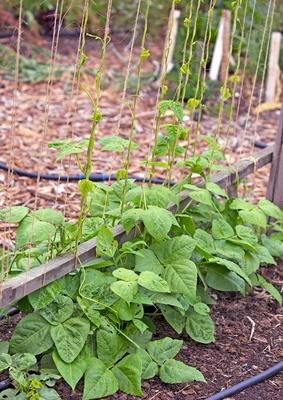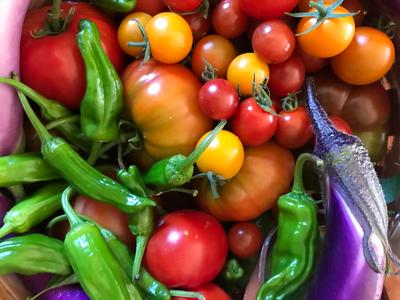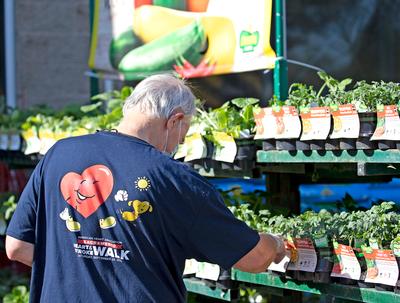Your Food Garden in Drought
Your Food Gardening in Drought

When facing a serious drought, we can be water-wise and successful in growing a food garden. Here are some things to consider when planning a food garden during a drought and some suggestions for optimizing water usage.
Start by Assessing How Much Water is Available
The first step in deciding to have a food garden is to determine if extra water beyond basic household needs of cooking, bathing, etc. is available. This includes rain collection systems as well as captured tap water (not to be confused with “graywater”). Buckets can be used to capture water in sinks and tubs while waiting for the water to get warm and then used to irrigate edibles. Note that collected roof water may have contaminants and should not be used for overhead watering of food crops. Graywater is untreated wastewater from clothes washers, showers, bathtubs, bathroom sinks, and laundry tubs that is used for outdoor watering. Graywater is an option for irrigating your ornamentals, but it should not be used to water root vegetables or any vegetables whose plant parts come into contact with the soil due to the potential that human pathogens might be present. In addition, you must be careful to avoid using household products that add salt, boron, or chlorine bleach to the soil. Check with your local building department for graywater regulations.
Develop a Food Garden Action Plan
If you determine that you have sufficient water, plan ahead to minimize the garden's water needs.
- COMPOST. Add organic matter to the soil. If soil is sandy, the addition of organic matter allows the soil to hold more water. Organic matter also helps open up the soil allowing roots to go deeper and find more water at lower depths if there is any. Higher soil nutrition helps plants produce better yields with the same amount of water. Avoid adding excessive amounts of nitrogen as this encourages lush leafy growth that requires more water to sustain.
- MULCH. Mulch keeps soil cool, conserves moisture, and reduces weeds. Use three to four inches on top of the soil. The larger the material size, the deeper layer you need to provide. Choose from straw, fallen leaves, hulls, shredded bark, grass clippings, and newspaper. It is not advisable to use plastic sheeting as mulch because it deprives the soil of much-needed oxygen. Keep mulch two inches away from the base of the plant to avoid the possibility of rot. When hand watering, pull back mulch so that water goes directly into the soil.
- USE A DRIP SYSTEM. Learn about individual plant moisture needs and group plants that have the same needs together on the same valve. Irrigate only as long as it takes to moisten the active root zone. Water, preferably, in the morning or in the cool hours of the evening so that soil stays evenly moist. Monitor and adjust the drip system as needed.
- BE SELECTIVE. Consider the water available to support crops through harvest, and grow only the amount and types of vegetables the family will consume. For example, plant two beds of vegetables instead of six; plant four tomatoes instead of ten. To get the most out of the water you apply, grow high-yielding vegetables like beans, chard, mustard, eggplants, peppers, tomatoes, squash, quinoa, and amaranth. Do not grow crops that need consistent moisture during the summer months. Examples include most brassicas (broccoli, cabbage, Brussels sprouts, kohlrabi, cauliflower, and radishes), lettuce and other greens, beets, carrots, and other root crops, celeriac, celery, leeks, and onions. Avoid these unless a particular variety has been bred to need less water. Generally, cool-season crops are not drought resistant, and growing them during the heat of the summer requires extra water to keep them cool.
Know when crops need the most water and adjust your watering schedule

- Sweet corn and some beans need considerable water to produce a good crop. Beans need water most when they are blooming and setting fruit.
- Corn needs water most during tasseling, sinking, and ear development. Yield is directly related to quantities of water, nitrogen, and spacing.
- Peas need water most during pod filling.
Other vegetables such as cucumbers and squash, and fruits, such as melons, need water most during flowering and fruiting. - Tomatoes, peppers, and eggplant need water most during flowering and fruiting. After tomatoes set fruit, they can do very well with reduced water.

Decide What to Grow and Plan Care Carefully
After deciding what to grow, choose varieties that tolerate dry conditions. Look for the terms “drought-resistant” or “drought-tolerant” in seed catalogs or on plant labels (note that “heat-tolerant” refers to above-ground air temperature and is not the same as drought-resistant or drought-tolerant). Even these varieties require water. Some water is needed to start seeds or establish a seedling, and to periodically irrigate the plant through the growing season. Selecting varieties that are described as “widely adapted” in addition to drought-resistant and drought-tolerant also may be helpful.
- LOOK FOR EARLY-MATURING OR SHORT-SEASON VARIETIES. A crop needing fewer days to mature requires less frequent irrigation before harvest (e.g., 62-day ‘Stupice’ vs. 85-day ‘Cherokee Purple’ tomato). Days to maturity will vary from one part of the country to another as well as from one microclimate to another

- LAYOUT PLANTING AREAS IN BLOCKS, NOT ROWS. As plants mature their foliage touches and creates an umbrella over the soil, shading roots, reducing evaporation, and creating a beneficial CO2 bubble on the underside of plants.
- PLANT DETERMINATE AND BUSH VARIETIES. Determinate tomato plants, for example, tend to be smaller in size than indeterminate types, so will use less water. Additionally, because they set most of their fruit at one time, the harvest period will be shorter, reducing the number of days irrigation is needed. Bush varieties of cucumber and squash are more compact than vining types and provide a better shade canopy to the soil below, using less water and reducing evaporation from the soil. Bush varieties of beans also provide shade protection to the soil and, because they tend to be determinate in nature, set most of their fruit at one time, resulting in a shorter harvest period.
- START SEEDS IN FLATS RATHER THAN DIRECT SOWING. Sowing seeds in a flat uses far less water than when seeds are sown directly in the garden bed. For example, if direct sowing a 5' x 5' block of corn, you would need to water 25 square feet of garden bed from the first day. However, if those seeds are sown in a flat and then transplanted when they reach 5 or 6 inches tall, for the first 20 to 30 days you will only use enough water to keep one flat moist.
- DRY FARM SOME CROPS. When we have winter rains, some of the water is stored in the soil for plants to use in the spring as the weather warms up and growth begins. Gardeners use this “bank” of available water to dry farm – a technique that depends on sufficient soil moisture and deep-rooted plants that scavenge to access water without adding much supplemental irrigation. Crops that can be successfully dry farmed include tomatoes, grapes, potatoes, winter squash, grains, and fruit trees. Keep in mind that while dry farming can produce fruit with much greater flavor concentration, you can also expect a significantly reduced yield.
- USE LIGHT-WEIGHT ROW COVERS AND PROVIDE SHADE. Cover plants as a means to collect dew. The collected dew will drop onto the soil and keeps it moist. While using row covers can help prevent insect damage, look under the cover from time to time to monitor plant growth and check for unwanted insects trapped inside. Heat-sensitive vegetables can benefit from being planted where they receive some afternoon shade. Plant them underneath or behind taller plants or consider using shade cloth.
- ELIMINATE WEEDS. Weeds compete for water. Be aggressive in removing them from growing areas.
- DETERMINE WHEN IT IS TIME TO WATER AGAIN. Use a soil moisture meter. Or squeeze the soil in your hand: if it sticks together, it is still moist; if it is crumbly and falls apart, it is time to water.
- HARVEST CROPS ON TIME. Pick crops at the peak of growth and flavor and remove plants that have stopped producing, eliminating the need to irrigate.
Resources
Read more about successfully growing food in your garden.
Have a gardening question? We'll help. You can reach us by:
- Emailing acmg@ucanr.edu. Please include a photo of the problem, if you can, plus your name, phone number, city and a description of the problem.
- Using our online form.
- By phone, during our office hours, 10 am to noon Wednesday and 11 am to 1 pm Thursday: 510-670-5645. At other times, please leave a message and we'll return your call during our office hours.
- In person at our Hayward office, during our office hours, only by appointment.


